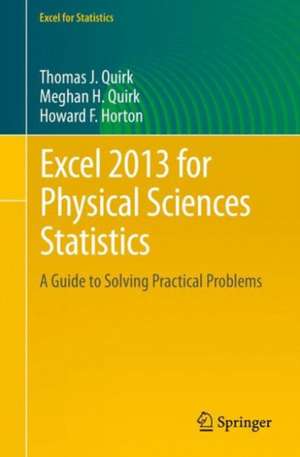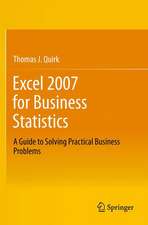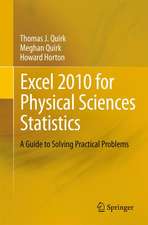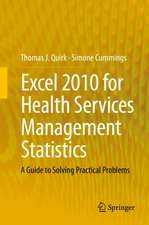Excel 2013 for Physical Sciences Statistics: A Guide to Solving Practical Problems: Excel for Statistics
Autor Thomas J. Quirk, Meghan H. Quirk, Howard F. Hortonen Limba Engleză Paperback – 18 mar 2016
Excel, a widely available computer program for students and managers, is also an effective teaching and learning tool for quantitative analyses in science courses. Its powerful computational ability and graphical functions make learning statistics much easier than in years past. However, Excel 2013 for Physical Sciences Statistics: A Guide to Solving Practical Problems is the first book to capitalize on these improvements by teaching students and managers how to apply Excel to statistical techniques necessary in their courses and work.
Each chapter explains statistical formulas and directs the reader to use Excel commands to solve specific, easy-to-understand science problems. Practice problems are provided at the end of each chapter with their solutions in an appendix. Separately, there is a full Practice Test (with answers in an Appendix) that allows readers to test what they have learned.
Din seria Excel for Statistics
-
 Preț: 357.43 lei
Preț: 357.43 lei -
 Preț: 392.60 lei
Preț: 392.60 lei -
 Preț: 391.99 lei
Preț: 391.99 lei -
 Preț: 393.35 lei
Preț: 393.35 lei -
 Preț: 321.26 lei
Preț: 321.26 lei - 17%
 Preț: 426.14 lei
Preț: 426.14 lei -
 Preț: 385.84 lei
Preț: 385.84 lei -
 Preț: 452.25 lei
Preț: 452.25 lei -
 Preț: 389.70 lei
Preț: 389.70 lei -
 Preț: 390.63 lei
Preț: 390.63 lei -
 Preț: 172.16 lei
Preț: 172.16 lei -
 Preț: 386.99 lei
Preț: 386.99 lei -
 Preț: 386.39 lei
Preț: 386.39 lei -
 Preț: 368.63 lei
Preț: 368.63 lei -
 Preț: 368.94 lei
Preț: 368.94 lei -
 Preț: 386.99 lei
Preț: 386.99 lei - 19%
 Preț: 471.73 lei
Preț: 471.73 lei - 15%
 Preț: 469.91 lei
Preț: 469.91 lei -
 Preț: 387.20 lei
Preț: 387.20 lei - 15%
 Preț: 525.66 lei
Preț: 525.66 lei -
 Preț: 386.22 lei
Preț: 386.22 lei - 15%
 Preț: 497.77 lei
Preț: 497.77 lei - 15%
 Preț: 497.96 lei
Preț: 497.96 lei -
 Preț: 485.84 lei
Preț: 485.84 lei - 19%
 Preț: 451.30 lei
Preț: 451.30 lei
Preț: 367.54 lei
Nou
Puncte Express: 551
Preț estimativ în valută:
70.34€ • 76.38$ • 59.08£
70.34€ • 76.38$ • 59.08£
Carte tipărită la comandă
Livrare economică 19-25 aprilie
Preluare comenzi: 021 569.72.76
Specificații
ISBN-13: 9783319289632
ISBN-10: 3319289632
Pagini: 150
Ilustrații: XVIII, 242 p. 162 illus., 1 illus. in color.
Dimensiuni: 155 x 235 x 14 mm
Greutate: 0.51 kg
Ediția:1st ed. 2016
Editura: Springer International Publishing
Colecția Springer
Seria Excel for Statistics
Locul publicării:Cham, Switzerland
ISBN-10: 3319289632
Pagini: 150
Ilustrații: XVIII, 242 p. 162 illus., 1 illus. in color.
Dimensiuni: 155 x 235 x 14 mm
Greutate: 0.51 kg
Ediția:1st ed. 2016
Editura: Springer International Publishing
Colecția Springer
Seria Excel for Statistics
Locul publicării:Cham, Switzerland
Public țintă
Upper undergraduateCuprins
Sample Size, Mean, Standard Deviation, and Standard Error of the Mean.- Random Number Generator.- Confidence Interval About the Mean Using the TINV Function and Hypothesis Testing.- One-Group t-Test for the Mean.- Two-Group t-Test of the Difference of the Means for Independent Groups.- Correlation and Simple Linear Regression.- Multiple Correlation and Multiple Regression.- One-Way Analysis of Variance (ANOVA).- Appendix A: Answers to End-of-Chapter Practice Problems.- Appendix B: Practice Test.- Appendix C: Answers to Practice Test.- Appendix D: Statistical Formulas.- Appendix E: t-table.
Recenzii
“This book is a well-written short book on the subject of statistical features of Excel 2013 with many examples and exercises related to the target audience. It is a great reference for those who need to use Excel for some introductory statistical concepts or as a supplement in an introductory course in statistics for nonmajors.” (Morteza Marzjarani, Technometrics, Vol. 59 (2), April, 2017)
“Excel 2013 for physical sciences statistics is an interesting and valuable little book. … It would also be valuable to a manager who has not done any statistical work in some time and needs a review before dealing with subordinates who are using statistics to justify their work or recommend decisions. Although the title says it is for physical sciences, it is equally applicable to other areas where statistics are used.” (Michael Moorman, Computing Reviews, computingreviews.com, August, 2016)
“Excel 2013 for physical sciences statistics is an interesting and valuable little book. … It would also be valuable to a manager who has not done any statistical work in some time and needs a review before dealing with subordinates who are using statistics to justify their work or recommend decisions. Although the title says it is for physical sciences, it is equally applicable to other areas where statistics are used.” (Michael Moorman, Computing Reviews, computingreviews.com, August, 2016)
Notă biografică
At the beginning of his academic career, Prof. Tom J. Quirk spent six years in educational research at The American Institutes for Research and Educational Testing Service. He then taught Social Psychology, Educational Psychology, General Psychology, Marketing, Management, and Accounting at Principia College, and is currently a Professor of Marketing in the George Herbert Walker School of Business & Technology at Webster University based in St. Louis, Missouri (USA) where he teaches Marketing Statistics, Marketing Research, and Pricing Strategies. He has written 60+ textbook supplements in Marketing and Management, published 20+ articles in professional journals, and presented 20+ papers at professional meetings. He holds a B.S. in Mathematics from John Carroll University, both an M.A. in Education and a Ph.D. in Educational Psychology from Stanford University, and an M.B.A. from The University of Missouri-St. Louis.
Dr. Meghan H. Quirk holds both a Ph.D. in Biological Education and an M.A. in Biological Sciences from the University of Northern Colorado (UNC) and a B.A. in Biology and Religion at Principia College in Elsah, Illinois. She has done research on foodweb dynamics at Wind Cave National Park in South Dakota and research in agro-ecology in Southern Belize. She has co-authored an article on shortgrass steppe ecosystems in Photochemistry & Photobiology. She was a National Science Foundation Fellow GK-12, and currently teaches in Bailey, Colorado.
Howard F. Horton holds an MS in Biological Sciences from the University of Northern Colorado (UNC) and a BS in Biological Sciences from Mesa State College. He has worked on research projects in Pawnee National Grasslands, Rocky Mountain National Park, Long Term Ecological Research at Toolik Lake, Alaska, and Wind Cave, South Dakota. He has co-authored articles in The International Journal of Speleology and The Journal of Cave and Karst Studies. He was a National Science Foundation Fellow GK-12, and a District Wildlife Manager with the Colorado Division of Parks and Wildlife. He is currently the Angler Outreach Coordinator for Colorado Parks and Wildlife (USA).
Dr. Meghan H. Quirk holds both a Ph.D. in Biological Education and an M.A. in Biological Sciences from the University of Northern Colorado (UNC) and a B.A. in Biology and Religion at Principia College in Elsah, Illinois. She has done research on foodweb dynamics at Wind Cave National Park in South Dakota and research in agro-ecology in Southern Belize. She has co-authored an article on shortgrass steppe ecosystems in Photochemistry & Photobiology. She was a National Science Foundation Fellow GK-12, and currently teaches in Bailey, Colorado.
Howard F. Horton holds an MS in Biological Sciences from the University of Northern Colorado (UNC) and a BS in Biological Sciences from Mesa State College. He has worked on research projects in Pawnee National Grasslands, Rocky Mountain National Park, Long Term Ecological Research at Toolik Lake, Alaska, and Wind Cave, South Dakota. He has co-authored articles in The International Journal of Speleology and The Journal of Cave and Karst Studies. He was a National Science Foundation Fellow GK-12, and a District Wildlife Manager with the Colorado Division of Parks and Wildlife. He is currently the Angler Outreach Coordinator for Colorado Parks and Wildlife (USA).
Textul de pe ultima copertă
This book shows the capabilities of Microsoft Excel in teaching physical sciences statistics effectively. Similar to the previously published Excel 2010 for Physical Sciences Statistics, this book is a step-by-step exercise-driven guide for students and practitioners who need to master Excel to solve practical science problems. If understanding statistics isn’t your strongest suit, you are not especially mathematically-inclined, or if you are wary of computers, this is the right book for you.
Suitable for undergraduates or graduate students
Includes 163 color screen shots so you can be sure you are performing Excel steps correctly
At the beginning of his academic career, Prof. Tom J. Quirk spent six years in educational research at The American Institutes for Research and Educational Testing Service. He then taught Social Psychology, Educational Psychology, General Psychology, Marketing, Management, and Accounting at Principia College, and is currently a Professor of Marketingin the George Herbert Walker School of Business & Technology at Webster University based in St. Louis, Missouri (USA) where he teaches Marketing Statistics, Marketing Research, and Pricing Strategies. He has written 60+ textbook supplements in Marketing and Management, published 20+ articles in professional journals, and presented 20+ papers at professional meetings. He holds a B.S. in Mathematics from John Carroll University, both an M.A. in Education and a Ph.D. in Educational Psychology from Stanford University, and an M.B.A. from The University of Missouri-St. Louis.
Dr. Meghan H. Quirk holds both a Ph.D. in Biological Education and an M.A. in Biological Sciences from the University of Northern Colorado (UNC) and a B.A. in Biology and Religion at Principia College in Elsah, Illinois. She has done research on foodweb dynamics at Wind Cave National Park in South Dakota and research in agro-ecology in Southern Belize. She has co-authored an article on shortgrass steppeecosystems in Photochemistry & Photobiology. She was a National Science Foundation Fellow GK-12, and currently teaches in Bailey, Colorado.
Howard F. Horton holds an MS in Biological Sciences from the University of Northern Colorado (UNC) and a BS in Biological Sciences from Mesa State College. He has worked on research projects in Pawnee National Grasslands, Rocky Mountain National Park, Long Term Ecological Research at Toolik Lake, Alaska, and Wind Cave, South Dakota. He has co-authored articles in Th e International Journal of Speleology and Th e Journal of Cave and Karst Studies. He was a National Science Foundation Fellow GK-12, and a District Wildlife Manager with the Colorado Division of Parks and Wildlife. He is currently the Angler Outreach Coordinator for Colorado Parks and Wildlife (USA).
Excel, a widely available computer program for students and managers, is also an effective teaching and learning tool for quantitative analyses in science courses. Its powerful computational ability and graphical functions make learning statistics much easier than in years past. However, Excel 2013 for Physical Sciences Statistics: A Guide to Solving Practical Problems is the first book to capitalize on these improvements by teaching students and managers how toapply Excel to statistical techniques necessary in their courses and work.
Each chapter explains statistical formulas and directs the reader to use Excel commands to solve specific, easy-to-understand science problems. Practice problems are provided at the end of each chapter with their solutions in an appendix. Separately, there is a full Practice Test (with answers in an Appendix) that allows readers to test what they have learned.
Suitable for undergraduates or graduate students
Includes 163 color screen shots so you can be sure you are performing Excel steps correctly
At the beginning of his academic career, Prof. Tom J. Quirk spent six years in educational research at The American Institutes for Research and Educational Testing Service. He then taught Social Psychology, Educational Psychology, General Psychology, Marketing, Management, and Accounting at Principia College, and is currently a Professor of Marketingin the George Herbert Walker School of Business & Technology at Webster University based in St. Louis, Missouri (USA) where he teaches Marketing Statistics, Marketing Research, and Pricing Strategies. He has written 60+ textbook supplements in Marketing and Management, published 20+ articles in professional journals, and presented 20+ papers at professional meetings. He holds a B.S. in Mathematics from John Carroll University, both an M.A. in Education and a Ph.D. in Educational Psychology from Stanford University, and an M.B.A. from The University of Missouri-St. Louis.
Dr. Meghan H. Quirk holds both a Ph.D. in Biological Education and an M.A. in Biological Sciences from the University of Northern Colorado (UNC) and a B.A. in Biology and Religion at Principia College in Elsah, Illinois. She has done research on foodweb dynamics at Wind Cave National Park in South Dakota and research in agro-ecology in Southern Belize. She has co-authored an article on shortgrass steppeecosystems in Photochemistry & Photobiology. She was a National Science Foundation Fellow GK-12, and currently teaches in Bailey, Colorado.
Howard F. Horton holds an MS in Biological Sciences from the University of Northern Colorado (UNC) and a BS in Biological Sciences from Mesa State College. He has worked on research projects in Pawnee National Grasslands, Rocky Mountain National Park, Long Term Ecological Research at Toolik Lake, Alaska, and Wind Cave, South Dakota. He has co-authored articles in Th e International Journal of Speleology and Th e Journal of Cave and Karst Studies. He was a National Science Foundation Fellow GK-12, and a District Wildlife Manager with the Colorado Division of Parks and Wildlife. He is currently the Angler Outreach Coordinator for Colorado Parks and Wildlife (USA).
Caracteristici
Presents practical examples of problems, taken from several areas in physical sciences Addresses both how to write statistical formulas and how to use drop-down menus to create formulas in Excel Includes 163 color screen shots to show the reader how to perform Excel steps correctly Includes supplementary material: sn.pub/extras








